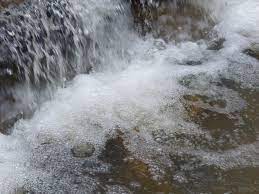- Designed for the NYC and NYC Watersheds TIC Program
- Presented at the 2009 NY Fall TIC Conference
- Conceived and written by Emily Hartzell, TIC teacher
Objectives: #
- Inspire participants to explore the NYC water supply system
- Show how art can demonstrate what students know about science
- Help students visualize the watershed
- Explain how gravity helps water travel to the city
- Make the students use their imagination and exercise their creative and artistic abilities
Background: #
The three watersheds that collect water for New York City are the Croton, Catskills, and Delaware Watersheds. 90% of New York City’s drinking water is brought from the watersheds by gravity. Water travels through large aqueducts, to one of the three New York City water tunnels, to the water pipes under the street, to the pipes in houses.
Materials: #
- Drawing supplies
- Magic School Bus at the Waterworks
- Tape
- More craft supplies for embellishment
Procedure: #
Method 1:
• Have the students read the Magic School Bus at the Waterworks while answering questions on a worksheet to help them identify the large components of the water supply system.
• Have them diagram the whole system on their own from the watersheds to their faucets.
• Discuss the diagram with the class and draw it on the whiteboard.
Method 2:
• Ask the student what the parts of the water supply system are and what order they’re in.
• Draw their answers on the board.
• Discuss the system until you have a diagram of the whole system.
• Split the watershed into four sections: watershed, reservoir and aqueduct; aqueduct with gatehouse; aqueduct into underground Hillview Reservoir, feeding into 3 water tunnels; 2 water tunnels (and incomplete #3) under city, feeding water mains, pipes, and up into buildings.
• Have the Students sit in groups of 4 at tables with markers and 4 sheets of letter-sized paper (and copies of Magic School Bus at the Waterworks for reference). Each student is assigned to draw one of the 4 sections.
• Tell the students put their 4 drawings together to assemble the whole system. They may need to make some changes so that the water flows all the way through the 4 drawings. Tape is supplied so students can assemble their drawings.
Method 3:
• Ask the student what the parts of the water supply system are and what order they’re in.
• Draw their answers on the board.
• Discuss the system until you have a diagram of the whole system.
• Split the students into groups and supply each group with different kinds of macaronis, cardboard, and glue.
• Have the students make their own versions of the watershed. Encourage them to build some on top of each other to create the mountains in the watersheds
Method 4:
• Ask the student what the parts of the water supply system are and what order they’re in.
• Draw their answers on the board.
• Discuss the system until you have a diagram of the whole system.
• Split the students into groups and supply each group with cardboard, colored paper, small cardboard boxes (buildings), small colored rectangle tiles (windows of buildings), tissue paper, pom poms, glitter, glue, and scissors
• Tell the students to set up the city and watershed sides of the cardboard using the colored paper and then create the watershed with whatever materials they want in whatever way they want. One suggestion is to use the cardboard boxes, colored paper, and small rectangle tiles to make the buildings, the pom poms and tissue paper to cover them to make the mountains in the watershed. They could then make lines with the liquid glue to show where the rivers flow and cover them with the blue glitter.
Wrap-Up: #
Follow up with students by asking the following questions:
1. How does the water supply system function?
2. What are the important parts of the watershed?
3. What is the force that brings the water to the city? How is this shown by your diagram?
4. How would your watershed function if it existed in real life?






